3D অ্যানাটমি মডেল
সম্পূর্ণ-ইন্টারেক্টিভ শিক্ষামূলক পুরুষ এবং মহিলা শারীরবৃত্তীয় মডেলগুলির সাথে আপনার শিক্ষায় অন্য মাত্রা যোগ করুন।
মানুষের শারীরস্থান সম্পর্কে শেখা আরও মজাদার ছিল না!
ক্রয়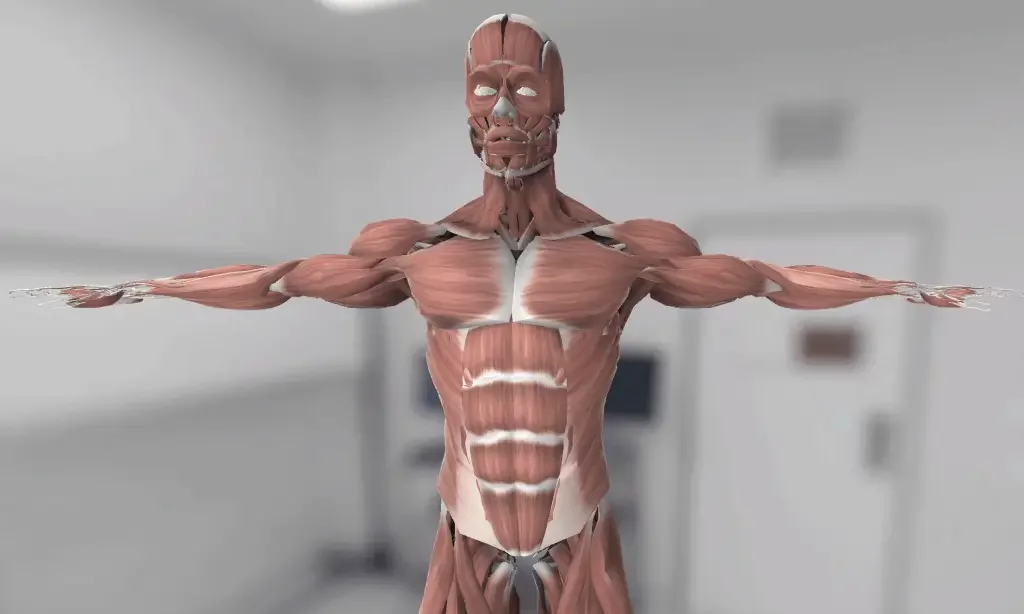
পরিপাকতন্ত্র আমাদের শক্তি এবং পুষ্টি পাওয়ার জন্য যে খাবার খাই তা ভেঙে ফেলতে দেয়। এটি সাধারণত গ্যাস্ট্রোইনটেস্টাইনাল ট্র্যাক্ট (এটিকে জিআই ট্র্যাক্ট বা পাচক ট্র্যাক্টও বলা হয়), লিভার, অগ্ন্যাশয় এবং পিত্তথলিতে বিভক্ত। জিআই ট্র্যাস্ট হল মুখ থেকে অনু পর্যন্ত লম্বা, মোচড়ানো টিউবের সাথে যুক্ত হওয়া অর্গানের একটি সিরিজ। পূর্ণাঙ্গ অঙ্গগুলি যা আপনাকে GI ট্র্যাস্ট তৈরি করে তা হল মুখ, খাদ্যনালী, পেট, ক্ষুদ্রান্ত্র, বৃহৎ অন্ত্র, এবং অনু।
এই অঙ্গগুলি ছয়টি কাজকে সংগঠিত করে: অন্বেষণ, পরিচালন, ব্যবস্থা, হজম, পরিহার এবং মলত্যাগ।
সুস্থ হোমিওস্ট্যাসিস (একটি ধ্রুবক অভ্যন্তরীণ পরিবেশ রক্ষণাবেক্ষণ) এবং মানবদেহের সর্বোত্তম কার্যকারিতার জন্য এই গুরুত্বপূর্ণ ফাংশনগুলি প্রয়োজনীয়।
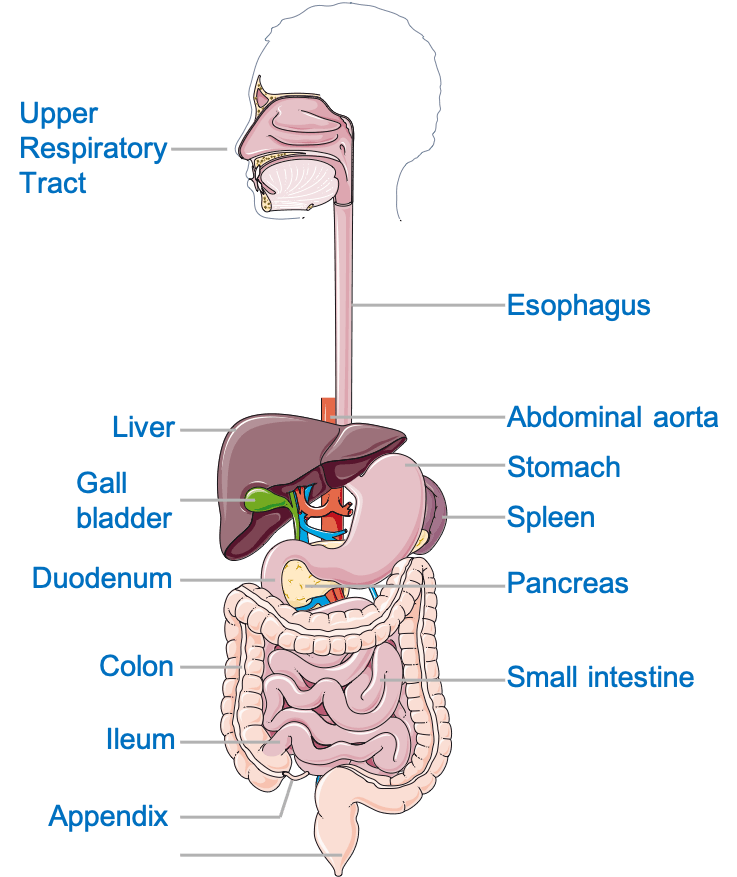
মুখ হল জিআই ট্র্যাক্টের সূচনা বিন্দু। মুখের মধ্যে উল্লেখযোগ্য পরিমাণে যান্ত্রিক হজম (খাদ্যকে ছোট ছোট টুকরোতে ভাগ করে) ঘটে। মুখ লালা দিয়ে খাবারকে লুব্রিকেট করতে সাহায্য করে এবং এটি ফ্যারিনক্স এবং খাদ্যনালী বরাবর সরাতে সাহায্য করে। যার কথা বলতে গেলে, খাদ্যনালী হল একটি পেশীবহুল নল যা পাকস্থলীর সাথে মুখকে সংযুক্ত করে এবং বোলাস (খাদ্যের একটি আধা-কঠিন বল যা চিবিয়ে লালার সাথে মিশ্রিত করা হয়) জন্য একটি পথ প্রদান করে।
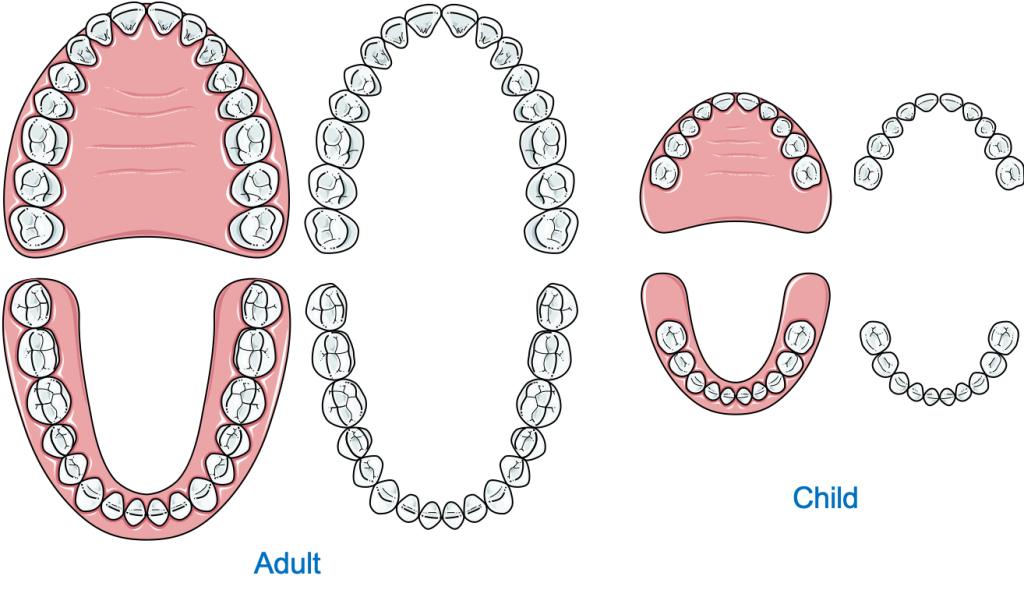
পাকস্থলীতে পৌঁছানো খাদ্য যান্ত্রিক ও রাসায়নিক উভয়ভাবেই সংরক্ষণ ও হজম হয়। রাসায়নিক হজম বলতে এমন একটি প্রক্রিয়াকে বোঝায় যার মাধ্যমে শরীর জটিল অদ্রবণীয় খাদ্যের অণুগুলিকে ভেঙে ফেলে যেমন, স্টার্চকে ছোট দ্রবণীয় অণুতে পরিণত করে যেমন, গ্লুকোজ, অ্যামিনো অ্যাসিড এবং ফ্যাটি অ্যাসিড। দ্য পেট একটি শক্তিশালী পেশীবহুল ব্যাগ যা পর্যায়ক্রমে সংকুচিত হয়, ভেঙ্গে যায় এবং খাবারকে গ্যাস্ট্রিক নিঃসরণের সাথে মিশ্রিত করে; জল, হাইড্রোক্লোরিক অ্যাসিড এবং প্রোটিস (প্রোটিন-হজমকারী এনজাইম) এর মিশ্রণ। এটি একটি antrum এবং pylorus সঙ্গে একটি কম এবং একটি বড় বক্রতা আছে. কাইম, গ্যাস্ট্রিক নিঃসরণের সাথে মিশ্রিত আধা-পাচ্য খাবার, পেরিস্টালিসিস (তরঙ্গের মতো নড়াচড়া) দ্বারা অন্ত্রে চালিত হয় যেখানে বাকি খাবার হজম হয় এবং শোষিত হয়।

ক্ষুদ্রান্ত্র পাকস্থলীর পাইলোরাস থেকে শুরু হয় এবং তিনটি ভাগে বিভক্ত হয়; duodenum, jejunum, এবং ileum. বেশিরভাগ হজম হয় ডুডেনাম এবং প্রাথমিক জেজুনামে। এটি একটি বিশেষায়িত এপিথেলিয়াম- ব্রাশ সীমানা সহ একটি 5-মিটার দীর্ঘ লুমিনাল কাঠামো।
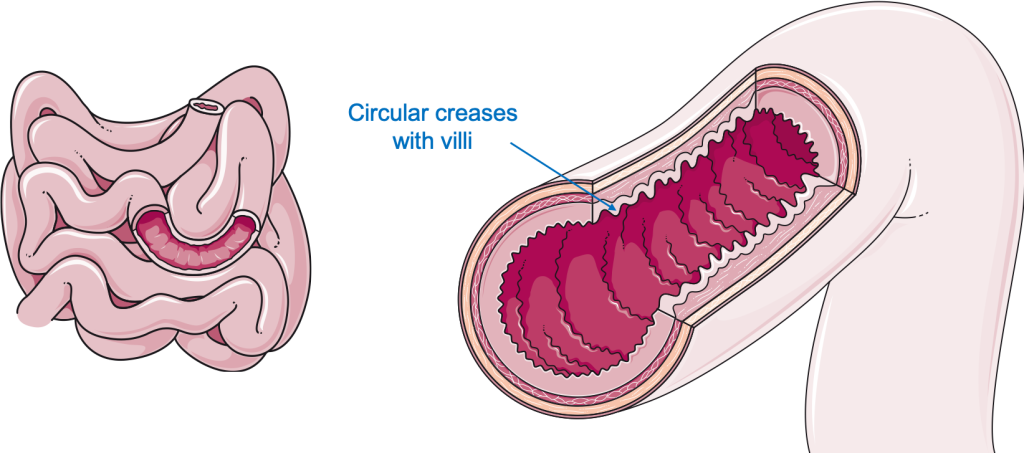
এই এপিথেলিয়ামে এর পৃষ্ঠ জুড়ে অসংখ্য ভিলি এবং মাইক্রোভিলি রয়েছে। ভিলি এবং মাইক্রোভিলি হল ছোট আঙুলের মতো অনুমান যা পৃষ্ঠের ক্ষেত্রফল (শোষণের জন্য উপলব্ধ এলাকা) ব্যাপকভাবে বৃদ্ধি করে। এই মাইক্রোভিলিগুলি অন্ত্রকে গামছার মতো চেহারা দেয়। অধিকাংশ দ্রবণীয় পুষ্টি উপাদান অর্থাৎ অ্যামিনো অ্যাসিড, গ্লুকোজ, ফ্রুক্টোজ, ফ্যাটি অ্যাসিড গ্লিসারল শোষিত হওয়ার পর খাদ্য বৃহৎ অন্ত্রের মলদ্বারের দিকে প্রবাহিত হয়।
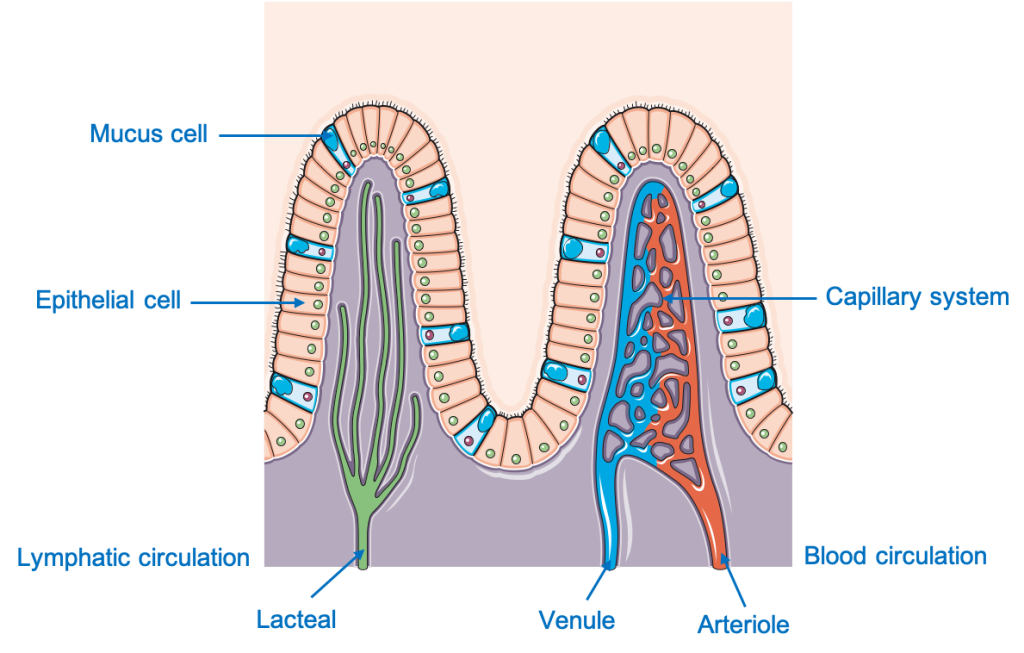
বৃহৎ অন্ত্র অর্থাৎ কোলন ileocecal জংশন থেকে শুরু হয় এবং মলদ্বার পর্যন্ত বিস্তৃত হয়। আরোহী, ট্রান্সভার্স, অবরোহ এবং সিগময়েড কোলন সবই বৃহৎ অন্ত্রের অংশ। কোলনের প্রাথমিক কাজ হল অবশিষ্ট অপাচ্য খাবার থেকে পানি এবং ইলেক্ট্রোলাইট শোষণ করা। কোলনে টিনিয়া-কোলাই নামক পেশীবহুল ব্যান্ড লুপের একটি সিরিজ রয়েছে যা পুরো কোলন জুড়ে বাল্ক নড়াচড়া তৈরি করতে এবং মলদ্বারে মল ঠেলে দিতে সাহায্য করে।
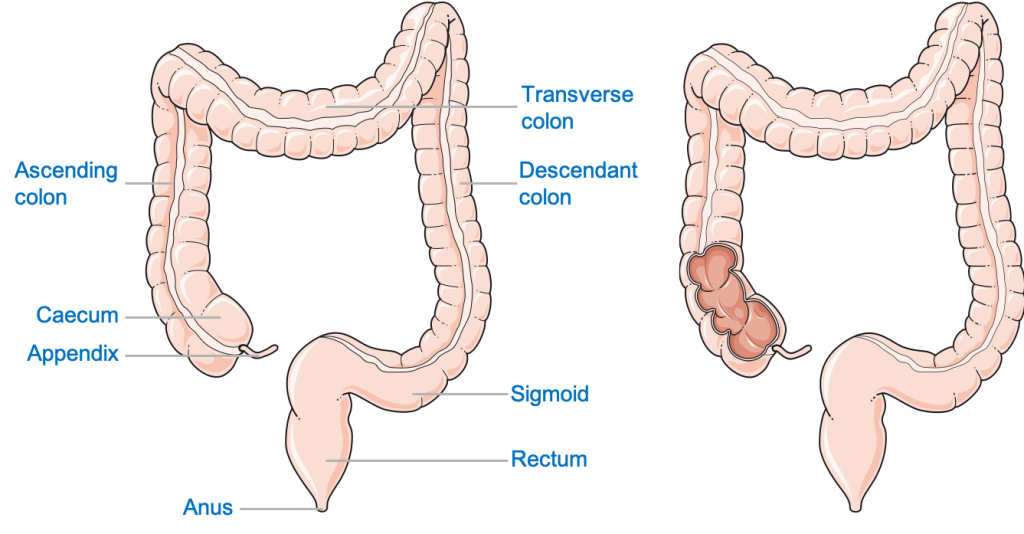
মলদ্বার সিগমায়েড কোলনকে মলদ্বারের সাথে সংযুক্ত করে। মল মলদ্বারে অস্থায়ীভাবে জমা হয় যতক্ষণ না এটি মলত্যাগ নামক একটি প্রক্রিয়ার মাধ্যমে মলদ্বারের মাধ্যমে শরীর থেকে বের হয়ে যায়।
সুস্থ শরীর বজায় রাখতে লিভার একটি গুরুত্বপূর্ণ কাজ করে। বেশিরভাগ মানুষের মধ্যে, এটি উপরের ডানদিকে পেটের অঞ্চলে, ডায়াফ্রামের ডান গম্বুজের নীচে এবং ডান ফুসফুসে অবস্থিত।

বহিরাগত বিষাক্ত পদার্থের ডিটক্সিফিকেশন, পুষ্টি সঞ্চয় করা এবং প্রোটিন এবং ট্রাইগ্লিসারাইড (চর্বি) এর সংশ্লেষণের মতো অন্যান্য অসংখ্য কাজ ছাড়াও লিভার পিত্ত উৎপন্ন করে। পিত্ত অস্থায়ীভাবে গলব্লাডারে (যকৃতের সাথে সংযুক্ত) সঞ্চিত হয় এবং ছোট অন্ত্রে নিঃসৃত হয় পিত্তনালীতে. পিত্ত বৃহৎ চর্বি অণুকে ছোট চর্বিযুক্ত ফোঁটায় পরিণত করে যা লিপেসেস (চর্বি-হজমকারী এনজাইম) দ্বারা কার্যকরভাবে হজম করা যায়।
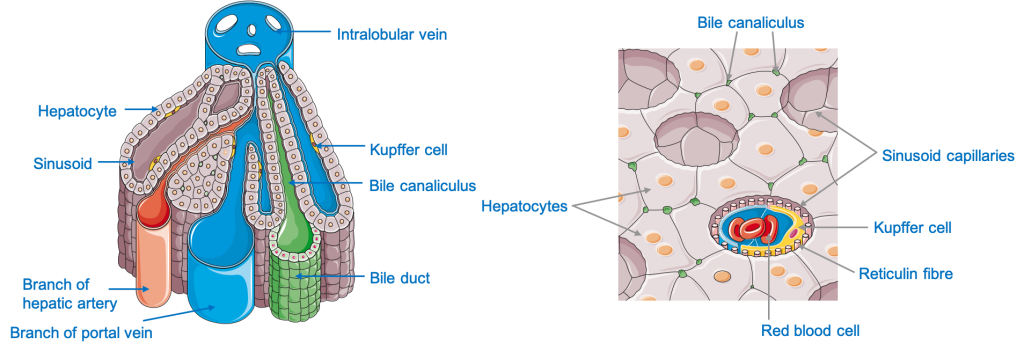
অগ্ন্যাশয় একটি পাতার আকৃতির অঙ্গ এবং এর কার্যের উপর ভিত্তি করে এটি দুটি ভাগে বিভক্ত: এক্সোক্রাইন এবং এন্ডোক্রাইন (হরমোন উৎপাদনকারী) অগ্ন্যাশয়। এক্সোক্রাইন অগ্ন্যাশয় খাদ্য ভাঙ্গনের জন্য প্রয়োজনীয় সমস্ত প্রাথমিক পাচক এনজাইম তৈরি করার জন্য দায়ী। অগ্ন্যাশয় নিঃসরণ একটি মিশ্রণ:

লালা হল একটি জলীয় নিঃসরণ, যা মুখের গহ্বরের গ্রন্থি গঠন দ্বারা উত্পাদিত হয়, এনজাইম যেমন কার্বোহাইড্রেস (কার্বোহাইড্রেট হজমকারী এনজাইম) এবং লিপেসেসের সাথে মিশ্রিত হয়। এটি খাবারের বোলাসকে নরম করতে সাহায্য করে এবং খাবারে উপস্থিত খাবার, বিশেষ করে স্টার্চ (কার্বোহাইড্রেট) আংশিকভাবে হজম করে। আমাদের শরীরে লালা গ্রন্থির তিনটি দ্বিপাক্ষিক (উভয় পাশে উপস্থিত) সেট রয়েছে। প্যারোটিড গ্রন্থি, সাবম্যান্ডিবুলার গ্রন্থি এবং সাবলিঙ্গুয়াল গ্রন্থি। কানের নীচে উপস্থিত প্যারোটিড গ্রন্থিগুলি প্রধান লালা গ্রন্থি। তাদের নাম অনুসারে, সাবম্যান্ডিবুলার গ্রন্থিগুলি এর নীচে অবস্থিত বাধ্যতামূলক (চোয়ালের হাড়) এবং জিহ্বার নীচের সাবলিংগুয়াল গ্রন্থি।
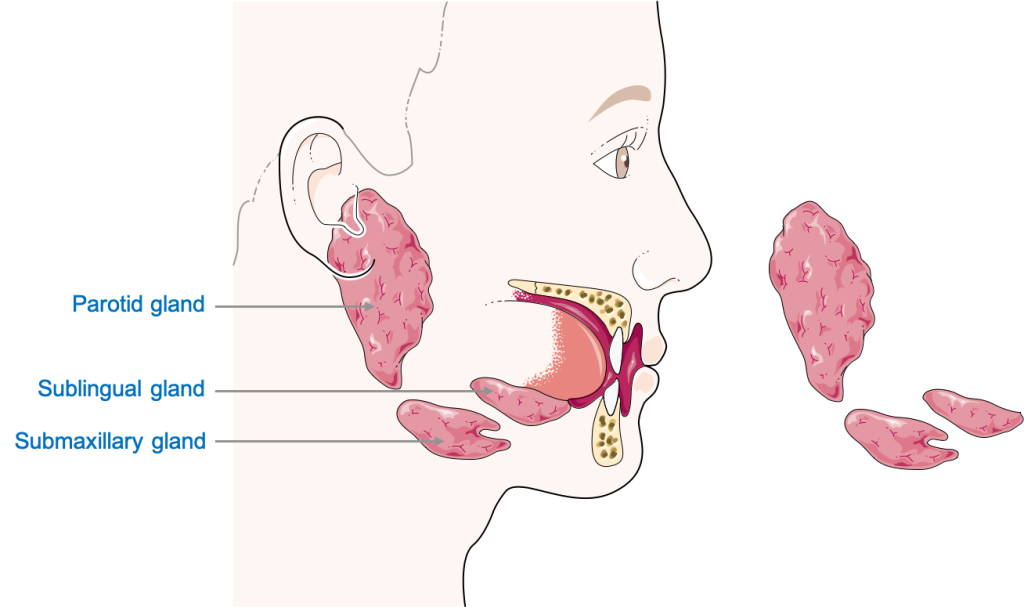
নিউরোভাসকুলার সরবরাহ বলতে রক্ত সরবরাহ এবং স্নায়ু সরবরাহ বোঝায়, যে সংযোগগুলি একটি অঙ্গকে জীবিত রাখার জন্য গুরুত্বপূর্ণ। হজম বিভিন্ন স্নায়ু এবং জাহাজের একটি সেট দ্বারা সরবরাহ করা হয়।
বুকের গহ্বর এবং এর গঠনগুলি ক্র্যানিয়াল স্নায়ু (CN), স্নায়ুগুলি সরাসরি মস্তিষ্ক বা মস্তিষ্কের স্টেম থেকে উদ্ভূত হয়। CN IX (9ম) এবং CN X (10তম) সহ CN V (5ম), ট্রাইজেমিনাল নার্ভ দ্বারা বেশিরভাগ উদ্ভাবন হয়। 10 তম সিএন, ভ্যাগাস নার্ভ, বেশিরভাগ জিআই ট্র্যাক্ট সরবরাহ করে। CN X এর মাধ্যমে উদ্দীপনা সমগ্র জিআই ট্র্যাক্টে পেরিস্টালিসিস এবং নিঃসরণ বাড়ায়। আরেকটি মূল বৈশিষ্ট্য যা লক্ষ্য করা যায় তা হল যে বেশিরভাগ পাচনতন্ত্রের উদ্ভাবন স্বায়ত্তশাসিত স্নায়ুতন্ত্র থেকে হয়, অর্থাৎ, এটি স্বেচ্ছাসেবী নিয়ন্ত্রণের অধীনে নয়। যকৃত এবং অগ্ন্যাশয় যোনি এবং স্প্ল্যাঞ্চনিক (সহানুভূতিশীল) স্নায়ু দ্বারা উদ্ভূত হয়।
মলদ্বার খালের নীচের অংশ, পেক্টিনেট লাইনের নীচে, সোমাটিক (স্বেচ্ছাসেবী) স্নায়ু, পুডেন্ডাল স্নায়ু থেকে উদ্ভূত। এটি আমাদের মলত্যাগের উপর নিয়ন্ত্রণ দেয়।
মুখের ভাস্কুলার সরবরাহে এক্সটার্নাল ক্যারোটিড আর্টারি (ইসিএ) এর বিভিন্ন শাখা জড়িত থাকে যেমন, জিহ্বার ভাষিক ধমনী। মুখের শিরাস্থ নিষ্কাশনটি ছোট শিরাগুলির একটি সিরিজের মাধ্যমে হয় যা অবশেষে অভ্যন্তরীণ জগুলার শিরায় নিষ্কাশন করে। খাদ্যনালী, পাকস্থলী এবং ডুওডেনামের প্রক্সিমাল (উপরের) অংশ সিলিয়াক (পেটের মহাধমনীর শাখা) ধমনীর শাখা দ্বারা সরবরাহ করা হয় এবং সংলগ্ন শিরা দ্বারা নিষ্কাশন করা হয় সিলিয়াক শিরায়। ডিউডেনামের দূরবর্তী অংশ, জেজুনাম, ইলিয়াম এবং ট্রান্সভার্স কোলনের দুই-তৃতীয়াংশ সবই সুপিরিয়র মেসেন্টেরিক আর্টারি (পেটের মহাধমনীর শাখা) দ্বারা সরবরাহ করা হয়। ট্রান্সভার্স কোলনের শেষ এক-তৃতীয়াংশ, অবরোহী এবং সিগমায়েড কোলন এবং পেকটিনেট লাইন পর্যন্ত পায়ূ খাল ইনফিরিয়র মেসেন্টেরিক আর্টারি (পেটের মহাধমনীর শাখা) দ্বারা সরবরাহ করা হয়। পেক্টিনেট লাইনের নীচে, মলদ্বার খাল পুডেনডাল ধমনী দ্বারা সরবরাহ করা হয়। এই গঠনগুলির শিরাস্থ নিষ্কাশন সংশ্লিষ্ট ধমনীগুলির শিরাগুলির মাধ্যমে হয়। বেশিরভাগ অগ্ন্যাশয় স্প্লেনিক ধমনীর শাখা দ্বারা সরবরাহ করা হয় (সেলিয়াক ধমনীর শাখা) এবং স্প্লেনিক শিরা দ্বারা নিষ্কাশন করা হয়।
লিভারের বিশেষ গুরুত্ব রয়েছে কারণ এটি হেপাটিক পোর্টাল শিরা দ্বারা জিআই ট্র্যাক্টের সাথে সংযুক্ত থাকে যা লিভারে পুষ্টি সমৃদ্ধ রক্ত সরবরাহ করে। যকৃতের প্যারেনকাইমা (টিস্যু) হেপাটিক ধমনী দ্বারা সরবরাহ করা হয়, যা সিলিয়াক ধমনী থেকে উৎপন্ন হয় এবং হেপাটিক শিরা দ্বারা নিষ্কাশন করা হয়: নিকৃষ্ট অংশের উপনদী ভেনা কাভা.
এই উজ্জ্বলের সাথে পাচক অঙ্গগুলির 3D স্থানিক সম্পর্ক সম্পর্কে আরও জানুন জীবন-আকারের শারীরবৃত্তীয় মডেল।
হেলথ লিটারেসি হাব ওয়েবসাইটে শেয়ার করা বিষয়বস্তু শুধুমাত্র তথ্যগত উদ্দেশ্যে প্রদান করা হয়েছে এবং এটি আপনার রাজ্য বা দেশের যোগ্য চিকিৎসা পেশাদারদের দ্বারা প্রদত্ত পরামর্শ, রোগ নির্ণয় বা চিকিত্সা প্রতিস্থাপনের উদ্দেশ্যে নয়। পাঠকদের অন্যান্য উত্সের সাথে প্রদত্ত তথ্য নিশ্চিত করতে এবং তাদের স্বাস্থ্য সম্পর্কিত যে কোনও প্রশ্ন থাকলে একজন যোগ্য চিকিত্সকের পরামর্শ নেওয়ার জন্য উত্সাহিত করা হয়। প্রদত্ত উপাদানের প্রয়োগ থেকে উদ্ভূত কোনো প্রত্যক্ষ বা পরোক্ষ পরিণতির জন্য হেলথ লিটারেসি হাব দায়বদ্ধ নয়।